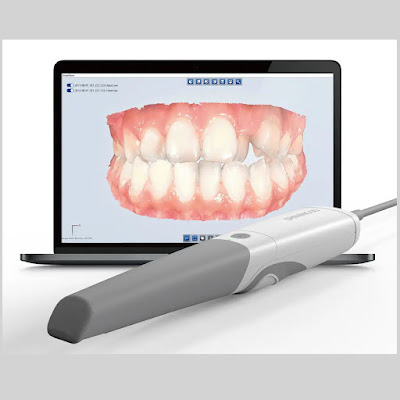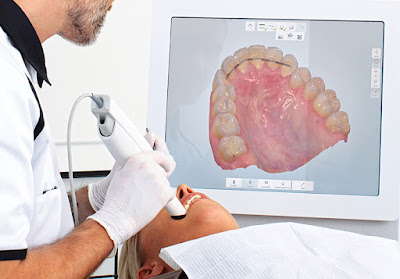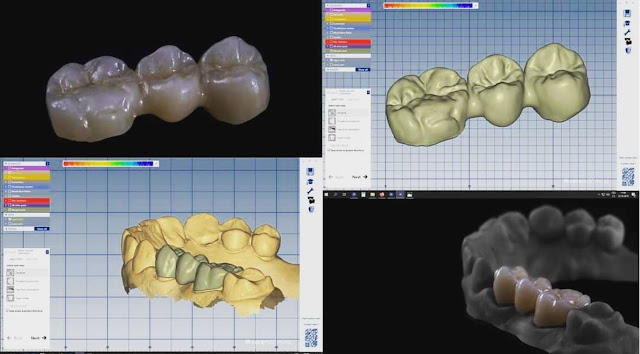Digital intraoral scanners have become an ongoing trend in the dental industry and the popularity is only getting bigger.
Intraoral scanner is ultra-modern dental
technology used in digital dentistry for making digital intra-oral impressions
of the patient’s oral cavity without using the conventional impression trays
and materials.
What are intraoral scanners?
An intraoral scanner is a handheld device used
to directly create digital impression data of the oral cavity. Light source
from the scanner is projected onto the scan objects, such as full dental
arches, and then a 3D model processed by the scanning software will be
displayed in real-time on a touch screen. The device provides accurate details
of the hard and soft tissues located in the oral area through high-quality
images. It is becoming a more popular choice for clinics and dentists due to
short lab turnaround times and excellent 3D image outputs.
Development of Intraoral scanners
In the earlier, methods of taking impressions
and making models were already available. But impression making seems
error-prone and is still uncomfortable to patients and time-consuming to
dentists. To overcome these limitations, intraoral digital scanners have
developed as an alternative to traditional impressions.
The advent of intraoral scanners has coincided with CAD/CAM technology development, bringing many benefits to the practitioners. The concept of computer-aided design/ computer-aided manufacturing (CAD/CAM) used by labs to fabricate precise restorations.
With the introduction of the digital scanner, dentistry is offered an exciting alternative to conventional impressions. Digital technology has continued to evolve over the past decade, producing scanners that are faster, more accurate and smaller than ever before.
Today, intraoral scanners and CAD/CAM technology offer easier treatment planning, more intuitive workflow, simplified learning curves, improved case acceptance, produce more accurate results, and expand the types of treatments available. No wonder more and more dental practices are realizing the need to enter the digital world— the future of dentistry.
How do intraoral scanners work?
An intraoral scanner consists of a handheld camera wand, a computer, and software. The small, smooth wand is connected to a computer that runs custom software that processes the digital data sensed by the camera. The smaller the scanning wand, the more flexible it is in reaching deep into the oral area to capture accurate and precise data. The procedure is less likely to induce gag response, making the scanning experience more comfortable for patients.
In the beginning, dentists will insert the scanning wand into the patient's mouth and gently move it over the surface area of the teeth. The wand automatically captures the size and shape of each tooth. It only takes a minute or two to scan, and the system will be able to produce a detailed digital impression. The dentist can view the real-time images on the computer, which can be magnified and manipulated to enhance details. The data will be transmitted to labs to fabricate any needed appliances. With this instant feedback, the whole process will be more efficient, saving time and allowing dentists to diagnose more patients.
What are the advantages?
Enhanced patient scanning experience
Digital scan reduces patient discomfort considerably because they do not have to endure the inconveniences and discomfort of traditional impressions, such as unpleasant impression trays and the possibility of gag reflex.
Time-saving and fast results
Reduces the chair time required for treatment and scan data can be sent immediately to the dental lab via the software. You can instantly connect with the dental Lab, reducing remakes and faster turnaround times compared to traditional practices.
Increased Accuracy
Intraoral scanners use the most advanced 3D
imaging technologies that capture the exact shape and contours of the teeth.
Enabling the dentist to have better scanning results and clearer teeth
structure information of patients and give accurate and appropriate treatment.
Better patient education
It’s a more direct and transparent process. After a full-arch scan, dentists can use 3D imaging technology to detect and diagnose dental diseases by providing a magnified, high-resolution image and share it digitally with the patients on the screen. By seeing their oral condition almost instantly in the virtual world, patients will be able to communicate effectively with their doctors and understand more about his dental problems and possible solutions.
Are intraoral scanners easy to use?
The scanning experience varies from person to
person, according to the feedback from many dentists, who are experienced and
enthusiastic about technological innovation may find it easy to adopt the new
device. Others who are used to traditional methods may find it a bit
complicated to use.
Let's Go Digital!
We believe you are aware that digital
technology is an inevitable trend in all fields. It just brings so many
benefits to both professionals and their clients, providing a simple, smooth
and precise workflow that we all want.









